九年级Module 2public holidays
- 格式:doc
- 大小:72.50 KB
- 文档页数:8
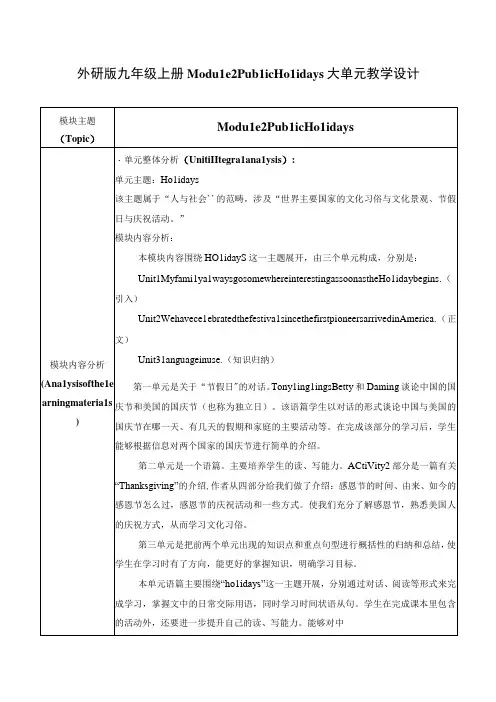
外研版九年级上册Modu1e2Pub1icHo1idays大单元教学设计国的某一节日做简单的介绍,感受我国文化的底蕴,培养学生热爱国家、名族的情怀。
核心语言知识分析:本模块主要语法状语从句的用法,主要学习时间状语从句的用法,使学生能够准确表达,达到自如运用的程度。
知识储备:1 .学生对“节假日”话题并不陌生,在七年级的时候就学过关于“春节”的相关内容,也能够做简单的介绍。
本模块主要谈论世界主要国家的节假日与庆祝活动。
内容比较丰富、有趣,所以学生对话题会比较感兴趣,也很容易进行讨论。
2 .学生在八年级学习了since›when 与whi1e 的基本用法,对这些词的用法有所感知和理解。
3 .学生掌握了一些有效的阅读策略。
可能面临的问题:1 .学生对话题比较熟悉,但是单词的储备还是欠缺,很多的词汇不熟悉,比较难开展讨论,可能只会在文中找些单词来进行描述,信息获取,文化知识的内化对于学生而言有一定难度。
2 .学生可能会分不清when 与whi1e 的用法,弄不清延续性动词和非延续性动词,造成理解上的一定困难。
3 .学生信息收集整理以及有逻辑的写作输出能力有待提高。
模块内容分析(Ana1ysisof the1earning materia1s)学情分析(Ana1ysisof thestudents)I 单元主题:节假日]庆节的庆祝方式,以及从哪一年开始庆祝。
学生能够在听、读任务完成后进行简单的表述。
在学习对话之前,活动1、2的设计为学生扫清了新词障碍。
Why:本单元语篇旨在让学生初步了解中、美两国的节日。
II.教学目标(TeaChingobjectives)在本课学习结束时,学生能够:1.熟练运用文中的重点句型和日常交际用语。
2.通过听、说活动,获取和梳理四大世界奇观的基本信息。
能够简单阐述自己的观点。
II1教学重、难点(Key&dif∏cu1tpoints)1.掌握文中重点词汇和句型。
2.掌握关于停顿的听力技巧,提高听的能力。
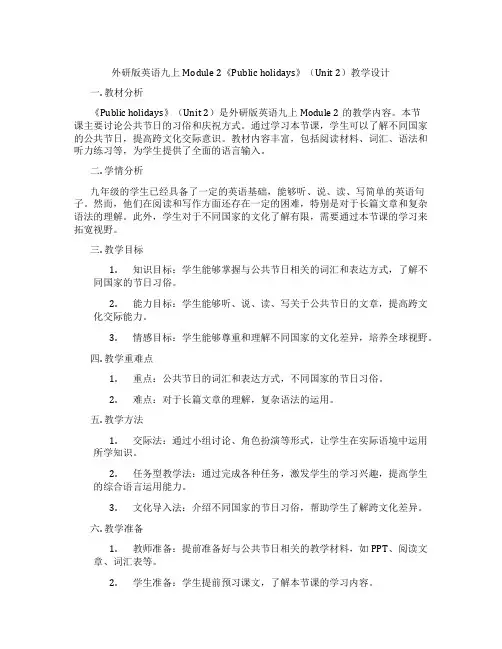
外研版英语九上Module 2《Public holidays》(Unit 2)教学设计一. 教材分析《Public holidays》(Unit 2)是外研版英语九上Module 2的教学内容。
本节课主要讨论公共节日的习俗和庆祝方式。
通过学习本节课,学生可以了解不同国家的公共节日,提高跨文化交际意识。
教材内容丰富,包括阅读材料、词汇、语法和听力练习等,为学生提供了全面的语言输入。
二. 学情分析九年级的学生已经具备了一定的英语基础,能够听、说、读、写简单的英语句子。
然而,他们在阅读和写作方面还存在一定的困难,特别是对于长篇文章和复杂语法的理解。
此外,学生对于不同国家的文化了解有限,需要通过本节课的学习来拓宽视野。
三. 教学目标1.知识目标:学生能够掌握与公共节日相关的词汇和表达方式,了解不同国家的节日习俗。
2.能力目标:学生能够听、说、读、写关于公共节日的文章,提高跨文化交际能力。
3.情感目标:学生能够尊重和理解不同国家的文化差异,培养全球视野。
四. 教学重难点1.重点:公共节日的词汇和表达方式,不同国家的节日习俗。
2.难点:对于长篇文章的理解,复杂语法的运用。
五. 教学方法1.交际法:通过小组讨论、角色扮演等形式,让学生在实际语境中运用所学知识。
2.任务型教学法:通过完成各种任务,激发学生的学习兴趣,提高学生的综合语言运用能力。
3.文化导入法:介绍不同国家的节日习俗,帮助学生了解跨文化差异。
六. 教学准备1.教师准备:提前准备好与公共节日相关的教学材料,如PPT、阅读文章、词汇表等。
2.学生准备:学生提前预习课文,了解本节课的学习内容。
七. 教学过程1.导入(5分钟)教师通过提问方式引导学生谈论他们喜欢的节日,激发学生的学习兴趣。
例如:“What is your favorite holiday? Why?”学生分享自己的经历,从而引出本节课的主题。
2.呈现(10分钟)教师展示PPT,呈现与公共节日相关的词汇和表达方式,如“Christmas, New Year, Easter, Dragon Boat Festival”等。
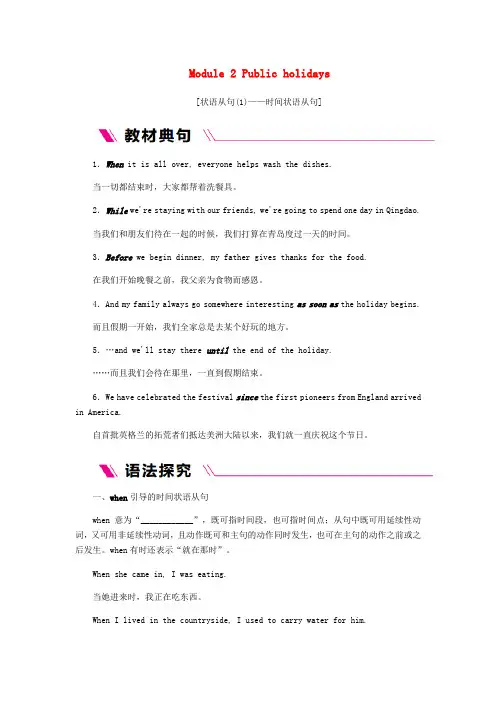
Module 2 Public holidays[状语从句(1)——时间状语从句]1.When it is all over, everyone helps wash the dishes.当一切都结束时,大家都帮着洗餐具。
2.While we're staying with our friends, we're going to spend one day in Qingdao.当我们和朋友们待在一起的时候,我们打算在青岛度过一天的时间。
3.Before we begin dinner, my father gives thanks for the food.在我们开始晚餐之前,我父亲为食物而感恩。
4.And my family always go somewhere interesting as soon as the holiday begins.而且假期一开始,我们全家总是去某个好玩的地方。
5.…and we'll stay there until the end of the holiday.……而且我们会待在那里,一直到假期结束。
6.We have celebrated the festival since the first pioneers from England arrived in America.自首批英格兰的拓荒者们抵达美洲大陆以来,我们就一直庆祝这个节日。
一、when引导的时间状语从句when意为“____________”,既可指时间段,也可指时间点;从句中既可用延续性动词,又可用非延续性动词,且动作既可和主句的动作同时发生,也可在主句的动作之前或之后发生。
when有时还表示“就在那时”。
When she came in, I was eating.当她进来时,我正在吃东西。
When I lived in the countryside, I used to carry water for him.当我住在农村时,我常常为他担水。
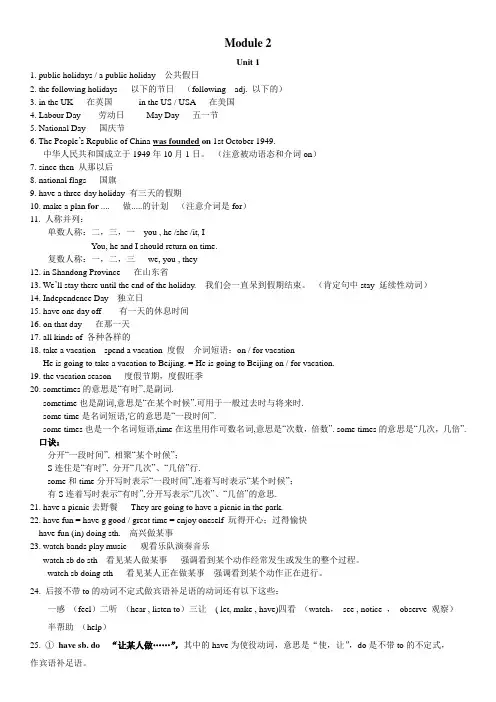
Module 2Unit 11. public holidays / a public holiday 公共假日2. the following holidays 以下的节日(following adj. 以下的)3. in the UK 在英国in the US / USA 在美国4. Labour Day 劳动日May Day 五一节5. National Day 国庆节6. The People’s Republic of China was founded on 1st October 1949.中华人民共和国成立于1949年10月1日。
(注意被动语态和介词on)7. since then 从那以后8. national flags 国旗9. have a three-day holiday 有三天的假期10. make a plan for .... 做.....的计划(注意介词是for)11. 人称并列:单数人称:二,三,一you , he /she /it, IYou, he and I should return on time.复数人称:一,二,三we, you , they12. in Shandong Province 在山东省13. We’ll stay there until the end of the holiday. 我们会一直呆到假期结束。
(肯定句中stay 延续性动词)14. Independence Day 独立日15. have one day off 有一天的休息时间16. on that day 在那一天17. all kinds of 各种各样的18. take a vacation spend a vacation 度假介词短语:on / for vacationHe is going to take a vacation to Beijing. = He is going to Beijing on / for vacation.19. the vacation season 度假节期,度假旺季20. sometimes的意思是“有时”,是副词.sometime也是副词,意思是“在某个时候”.可用于一般过去时与将来时.some time是名词短语,它的意思是“一段时间”.some times也是一个名词短语,time在这里用作可数名词,意思是“次数,倍数”. some times的意思是“几次,几倍”.口诀:分开“一段时间”,相聚“某个时候”;S连住是“有时”,分开“几次”、“几倍”行.some和time分开写时表示“一段时间”,连着写时表示“某个时候”;有S连着写时表示“有时”,分开写表示“几次”、“几倍”的意思.21. have a picnic去野餐They are going to have a picnic in the park.22. have fun = have g good / great time = enjoy oneself 玩得开心;过得愉快have fun (in) doing sth. 高兴做某事23. watch bands play music 观看乐队演奏音乐watch sb do sth 看见某人做某事强调看到某个动作经常发生或发生的整个过程。
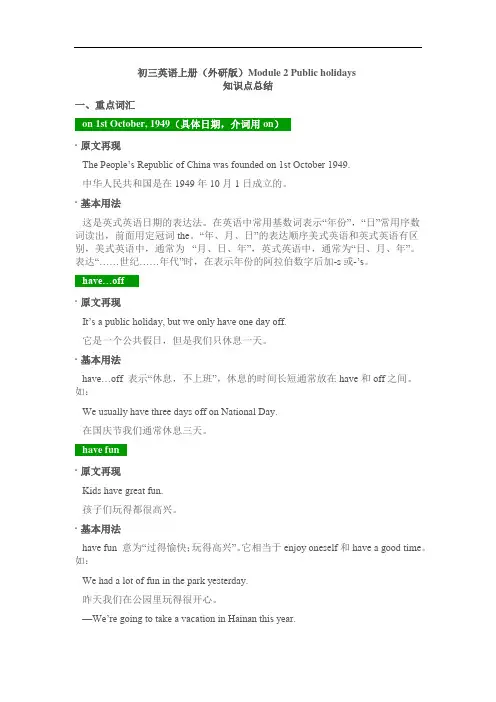
初三英语上册(外研版)Module 2 Public holidays知识点总结一、重点词汇·原文再现The People’s Republic of China was founded on 1st October 1949.中华人民共和国是在1949年10月1日成立的。
·基本用法这是英式英语日期的表达法。
在英语中常用基数词表示“年份”,“日”常用序数词读出,前面用定冠词the。
“年、月、日”的表达顺序美式英语和英式英语有区别,美式英语中,通常为“月、日、年”,英式英语中,通常为“日、月、年”。
表达“……世纪……年代”时,在表示年份的阿拉伯数字后加-s或-’s。
·原文再现It’s a public holiday, but we only have one day off.它是一个公共假日,但是我们只休息一天。
·基本用法have…off 表示“休息,不上班”,休息的时间长短通常放在have和off之间。
如:We usually have three days off on National Day.在国庆节我们通常休息三天。
·原文再现Kids have great fun.孩子们玩得都很高兴。
·基本用法have fun 意为“过得愉快;玩得高兴”。
它相当于enjoy oneself和have a good time。
如:We had a lot of fun in the park yesterday.昨天我们在公园里玩得很开心。
—We’re going to take a vacation in Hainan this year.今年我们将在海南度假。
—Have fun!祝你们玩得愉快!·知识拓展--相关句型/结构have fun in doing sth. 做某事很愉快。
如:I have fun flying kites.我享受放风筝的乐趣。
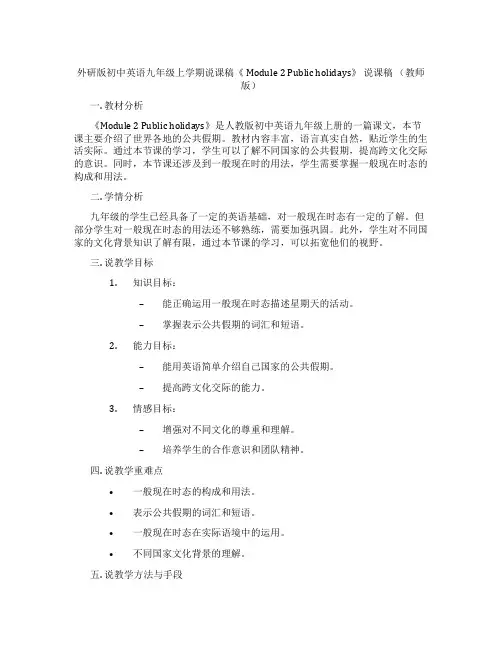
外研版初中英语九年级上学期说课稿《 Module 2 Public holidays》说课稿(教师版)一. 教材分析《Module 2 Public holidays》是人教版初中英语九年级上册的一篇课文,本节课主要介绍了世界各地的公共假期。
教材内容丰富,语言真实自然,贴近学生的生活实际。
通过本节课的学习,学生可以了解不同国家的公共假期,提高跨文化交际的意识。
同时,本节课还涉及到一般现在时的用法,学生需要掌握一般现在时态的构成和用法。
二. 学情分析九年级的学生已经具备了一定的英语基础,对一般现在时态有一定的了解。
但部分学生对一般现在时态的用法还不够熟练,需要加强巩固。
此外,学生对不同国家的文化背景知识了解有限,通过本节课的学习,可以拓宽他们的视野。
三. 说教学目标1.知识目标:–能正确运用一般现在时态描述星期天的活动。
–掌握表示公共假期的词汇和短语。
2.能力目标:–能用英语简单介绍自己国家的公共假期。
–提高跨文化交际的能力。
3.情感目标:–增强对不同文化的尊重和理解。
–培养学生的合作意识和团队精神。
四. 说教学重难点•一般现在时态的构成和用法。
•表示公共假期的词汇和短语。
•一般现在时态在实际语境中的运用。
•不同国家文化背景的理解。
五. 说教学方法与手段1.教学方法:–任务型教学法:通过完成各种任务,激发学生的学习兴趣,提高学生的参与度。
–交际型教学法:通过小组讨论、角色扮演等形式,培养学生的交际能力。
2.教学手段:–多媒体教学:利用PPT、视频等手段,丰富教学内容,提高学生的学习兴趣。
–网络资源:利用网络资源,让学生了解不同国家的公共假期,拓宽视野。
六. 说教学过程•教师通过提问,引导学生谈论自己喜欢的公共假期,激发学生的学习兴趣。
•教师展示各国公共假期的图片,引导学生用英语进行描述。
•学生分组,每组选择一个国家的公共假期,用英语进行介绍。
•学生模拟在国外旅游,用英语交流各国公共假期的信息。
•教师引导学生总结本节课所学内容,加深记忆。
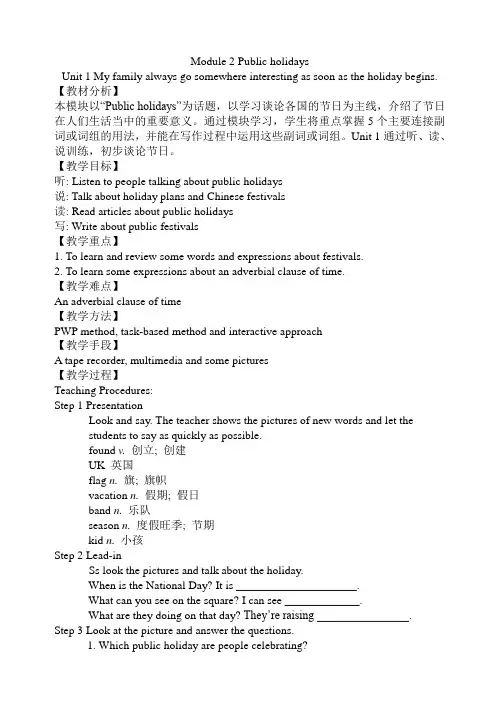
Module 2 Public holidaysUnit 1 My family always go somewhere interesting as soon as the holiday begins. 【教材分析】本模块以“Public holidays”为话题,以学习谈论各国的节日为主线,介绍了节日在人们生活当中的重要意义。
通过模块学习,学生将重点掌握5个主要连接副词或词组的用法,并能在写作过程中运用这些副词或词组。
Unit 1通过听、读、说训练,初步谈论节日。
【教学目标】听: Listen to people talking about public holidays说: Talk about holiday plans and Chinese festivals读: Read articles about public holidays写: Write about public festivals【教学重点】1. To learn and review some words and expressions about festivals.2. To learn some expressions about an adverbial clause of time.【教学难点】An adverbial clause of time【教学方法】PWP method, task-based method and interactive approach【教学手段】A tape recorder, multimedia and some pictures【教学过程】Teaching Procedures:Step 1 PresentationLook and say. The teacher shows the pictures of new words and let thestudents to say as quickly as possible.found v.创立; 创建UK 英国flag n.旗; 旗帜vacation n.假期; 假日band n.乐队season n.度假旺季; 节期kid n.小孩Step 2 Lead-inSs look the pictures and talk about the holiday.When is the National Day? It is _____________________.What can you see on the square? I can see _____________.What are they doing on that day? They’re raising ________________.Step 3 Look at the picture and answer the questions.1. Which public holiday are people celebrating?2. When is this holiday in China?Keys: People are celebrating Labour Day.This holiday is on 1st May in China.Step 4 Complete the sentences with the dates of the following holidays in China, the UKand the US.Look at each picture and fill in the blanks with the dates.1. Labour Day in China is on ________________.2. May Day in the UK is on _______________.3. Labour Day in the US is on _____________.Step 5 Listen and check.1st Maythe first Monday in Maythe first Monday in SeptemberStep 6 Listen and answer the following questions.1. When was the People’s Republic of China founded?2. Do people have one day off on Independence Day?3. Does Lingling have any plans for the National Day this year?4. When is the start of the vacation season in the US?5. Do people have a national day in the UK?Keys: On 1st October 1949.Yes, they do.Her parents and she are going to visit some friends in Shangdong Province.Independence Day.No, they don’t.Step 7 ReadingChina: National Day 1st October three dayscelebrating with flowers and national flags 1949US: Independence Day 4th July one daycelebrating with flags, picnics and watching bands play music inparks1777the________ season.2. On 1st October, you can see the national ________ everywhere in China.3. The US was _________ in 1776.4. What kinds of __________ are there on 1st January?Keys: vacation flags founded activitiesStep 8 Language pointsLet Ss know about the main points in the passage and master.1. The People’s Republic of China was founded on 1st October 1949.found表示“建立,创立”。
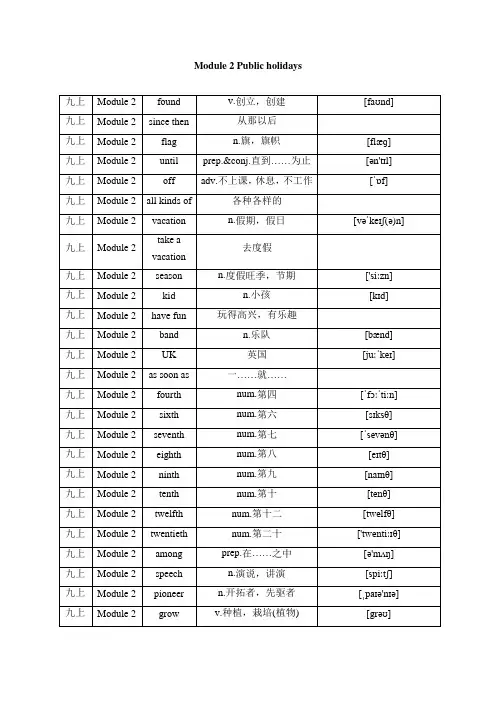
Module 2 Public holidays②The woman teacher is among some flowers and cats. 这位女老师在一些花和猫之间。
6. in the seventeenth century在十七世纪【考点】英语世纪和年代表达法(1)世纪可以用定冠词加序数词加century表示。
eg:the eighteenth century 十八世纪(2)世纪+年代是由定冠词和基数词表示的世纪加十位整数的复数形式构成。
eg:in the nineteen thirties/1930's 在二十世纪三十年代7. die /daɪ/ v.死;死亡例:His father died five years ago.五年前他父亲去世了。
【考点】辨析die,dying和deathdying dying 既是die的现在分词,也是一个形容词,意为“将要死的,濒临死亡的”。
The doctor is operating on a dyingmonkey.death 是名词,意为“死亡”。
It was a matter of life and death.这是生死攸关的事情。
8. following/'fɒləʊɪŋ/ adj.接着的;接下来的例:the following day 第二天【考点一】following为形容词,常用来作定语,其动词形式为follow,意为“跟上”。
例:Sorry, I can't follow you. Could you speak slowly?对不起,我没有听明白。
你能说慢一点儿吗?【考点二】区分following与nextfollowing和next前常加定冠词the,the following指紧随其后的,有一定的顺序性;the next指接下来的或下一个。
1. public holiday公共假日2. Labour Day劳动节3. the People's Republic of China中华人民共和国4. be founded(被)成立;创立。
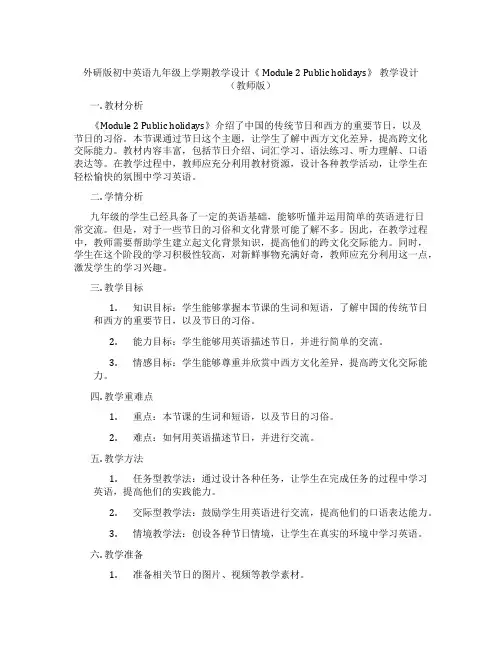
外研版初中英语九年级上学期教学设计《 Module 2 Public holidays》教学设计(教师版)一. 教材分析《Module 2 Public holidays》介绍了中国的传统节日和西方的重要节日,以及节日的习俗。
本节课通过节日这个主题,让学生了解中西方文化差异,提高跨文化交际能力。
教材内容丰富,包括节日介绍、词汇学习、语法练习、听力理解、口语表达等。
在教学过程中,教师应充分利用教材资源,设计各种教学活动,让学生在轻松愉快的氛围中学习英语。
二. 学情分析九年级的学生已经具备了一定的英语基础,能够听懂并运用简单的英语进行日常交流。
但是,对于一些节日的习俗和文化背景可能了解不多。
因此,在教学过程中,教师需要帮助学生建立起文化背景知识,提高他们的跨文化交际能力。
同时,学生在这个阶段的学习积极性较高,对新鲜事物充满好奇,教师应充分利用这一点,激发学生的学习兴趣。
三. 教学目标1.知识目标:学生能够掌握本节课的生词和短语,了解中国的传统节日和西方的重要节日,以及节日的习俗。
2.能力目标:学生能够用英语描述节日,并进行简单的交流。
3.情感目标:学生能够尊重并欣赏中西方文化差异,提高跨文化交际能力。
四. 教学重难点1.重点:本节课的生词和短语,以及节日的习俗。
2.难点:如何用英语描述节日,并进行交流。
五. 教学方法1.任务型教学法:通过设计各种任务,让学生在完成任务的过程中学习英语,提高他们的实践能力。
2.交际型教学法:鼓励学生用英语进行交流,提高他们的口语表达能力。
3.情境教学法:创设各种节日情境,让学生在真实的环境中学习英语。
六. 教学准备1.准备相关节日的图片、视频等教学素材。
2.准备生词和短语的卡片。
3.准备听力材料和练习题。
4.准备口语交流的话题。
七. 教学过程1.导入(5分钟)利用图片和视频展示各种节日,引导学生谈论他们喜欢的节日。
教师通过提问,了解学生对节日的了解程度,为接下来的教学做铺垫。
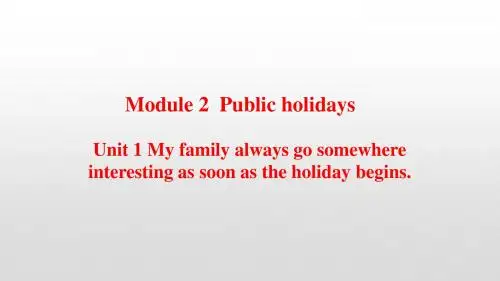
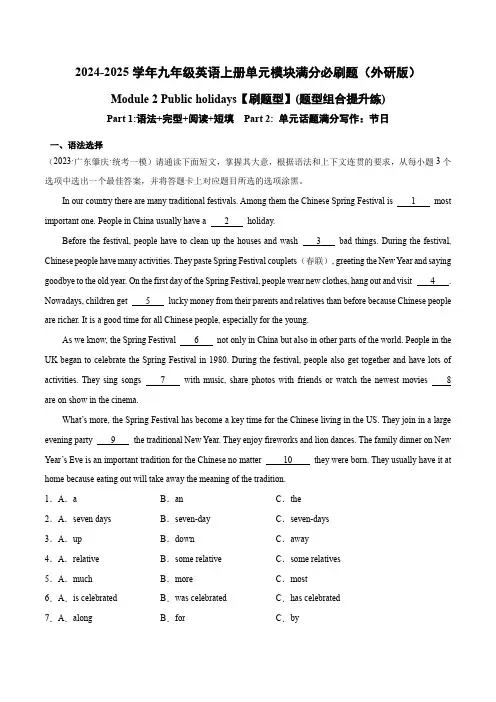
2024-2025学年九年级英语上册单元模块满分必刷题(外研版)Module 2 Public holidays【刷题型】(题型组合提升练)Part 1:语法+完型+阅读+短填Part 2: 单元话题满分写作:节日一、语法选择(2023·广东肇庆·统考一模)请通读下面短文,掌握其大意,根据语法和上下文连贯的要求,从每小题3个选项中选出一个最佳答案,并将答题卡上对应题目所选的选项涂黑。
In our country there are many traditional festivals. Among them the Chinese Spring Festival is 1 most important one. People in China usually have a 2 holiday.Before the festival, people have to clean up the houses and wash 3 bad things. During the festival, Chinese people have many activities. They paste Spring Festival couplets(春联), greeting the New Year and saying goodbye to the old year. On the first day of the Spring Festival, people wear new clothes, hang out and visit 4 . Nowadays, children get 5 lucky money from their parents and relatives than before because Chinese people are richer. It is a good time for all Chinese people, especially for the young.As we know, the Spring Festival 6 not only in China but also in other parts of the world. People in the UK began to celebrate the Spring Festival in 1980. During the festival, people also get together and have lots of activities. They sing songs 7 with music, share photos with friends or watch the newest movies 8 are on show in the cinema.What’s more, the Spring Festival has become a key time for the Chinese living in the US. They join in a large evening party 9 the traditional New Year. They enjoy fireworks and lion dances. The family dinner on New Year’s Eve is an important tradition for the Chinese no matter 10 they were born. They usually have it at home because eating out will take away the meaning of the tradition.1.A.a B.an C.the2.A.seven days B.seven-day C.seven-days3.A.up B.down C.away4.A.relative B.some relative C.some relatives5.A.much B.more C.most6.A.is celebrated B.was celebrated C.has celebrated7.A.along B.for C.by8.A.which B.that C.who9.A.welcome B.welcoming C.to welcome10.A.where B.why C.how(2023·广东清远·统考一模)With the coming of the Spring Festival, eight foreign college students made a big special gift. They wanted to thank their teachers 11 helped them get over trouble in 2020. 12 special gift is Laba congee(腊八粥).The Laba Festival falls on 13 day of the 12th month on the Chinese lunar calendar. It is traditional to cook congee at the Laba Festival. People boil rice in water until it becomes thick. They also add other grains(谷物)in it. The congee 14 with family members to welcome the new year.“With the coming of the Laba, we hope everyone will be safe and thank our teachers 15 they gave us much care during the hard periods. They brought us things we needed and always encouraged us 16 difficulties bravely,” one student said.In China, food and festivals are often connected. For many Chinese people, traditional food is as 17 as other celebration(庆祝)activities during festivals. The food carries good wishes. That could be the reason why today traditional food is still so popular among people of different 18 In order to cook delicious congee, these foreign students asked their Chinese friends where they could buy the best grains. At last, they 19 the grains online from Northeast China.“We also want to thank our students for sharing congee with us. They may not speak Chinese, but I can feel 20 hearts. This is not only a bowl of congee but also a symbol of love for China,” one of the teachers said. 11.A.whom B.who C.which12.A.The B.Some C.A13.A.eight B.eighth C.the eighth14.A.shared B.is shared C.shares15.A.because B.and C.but16.A.facing B.face C.to face17.A.important B.more important C.the most important18.A.ages B.age C.age’s19.A.buy B.bought C.will buy20.A.they B.theirs C.their二、完形填空paying respect to a person’s ancestors(祖先). So, on Tomb Sweeping Day, families visit their ancestors’ tombs to show their 22 . It usually falls on April 4th or 5th.It gets its name from a story. In ancient China, Chong Er and Jie Zitui met a lot of trouble, but Jie always made Chong Er live 23 . Jie never told him any pain. Later Chong Er became king, and he gave 24 to many who ever helped him. However, he forgot Jie. When someone reminded him of Jie, he came to know he should 25 Jie’s help a lot. To his 26 , Jie had died from a big fire. To memorize him, the king 27 this day. He ordered that no fire could be set on this day.Apart from visiting tombs, people also go for walks, plant trees and fly kites. Some take some 28 flowers to the tombs to show their miss. And it’s very green for the environment. After that, some families usually take a relaxing 29 . Traveling in the countryside is a good 30 for them after full workdays. It’s certainly a good time for families to get together.21.A.allows B.names C.means D.agrees22.A.respect B.benefit C.prize D.reply23.A.cheaply B.normally C.directly D.excitedly24.A.efforts B.awards C.dreams D.lessons25.A.hand out B.ask about C.thanks for D.take up26.A.anger B.worry C.happiness D.sadness27.A.happened B.improved C.created D.learned28.A.fresh B.pretty C.narrow D.single29.A.race B.tour C.style D.joke30.A.choice B.reason C.habit D.guide(2023·江苏南京·统考二模)请认真阅读下面短文,从短文后各题所给的A、B、C、D四个选项中,选出最佳选项。
Module 2the United Nations (u.n.)联合国found 创建flag 旗帜holiday 假期go on holiday 去度假season 季节as soon as 一···就···fourth 第四sixth 第六seventh 第七eighth 第八ninth 第九tenth 第十twelfth 第十二twentieth 第二十在…..之中speech 演说,讲演pioneer 开拓者,先驱者grow种植,栽植corn玉米,谷物following接下来的,接着的lay摆放lay the table摆放餐具dish盘,碟plenty 大量,众多plenty of丰富的,充足的Module 2 Public HolidaysUnit 1 My family always go somewhere interesting as soon as the holiday begins.Tony: The First of October is China's National Day, isn 't it, Lingling?Lingling: Yes. The People's Republic of China was founded on 1st October 1949. People have celebrated the National Day since then. There are flowers and national flagseverywhere, and we have a three-day holiday. Tony: Do you have any plans for theholiday this year?Lingling: Yes. My parents and I are going to visit some friends in Shandong Province and will stay there until the end of the holiday. While we're staying with our friends, we'regoing to spend one day in Qingdao. When is your national day, Betty'?Betty : Our national day is called Independence Day. It's on 4th July. We've celebrated it since 1777. It's a public holiday, but we only have one day off. On that day, there are allkinds of holiday activities. It's the start of the vacation season. and most people take avacation sometime in July or August.Lingling: And is there anything special on that day?Betty: Well, you can see American flags everywhere. We usually have a picnic somewhere nice. Kids have great fun. We also watch bands play music in public parks. Daming: Do you have a national day in the UK, Tony?Tony: No, we don't - we celebrate Christmas with a two-day holiday. And my family always go somewhere interesting as soon as the holiday begins.Unit 2 We have celebrated the festival since the first pioneers arrived in America.ThanksgivingThanksgiving is an American festival. It is celebrated on the fourth Thursday in November. It is a time for a special dinner among family and friends. People make short speeches and give thanks for their food.We have celebrated the festival since the first pioneers from England arrived in America by ship in the seventeenth century. While they were crossing the Atlantic, many people died and after they landed, their first winter was worse than any English winter. The local people, the Native Americans 土著印第安人, taught the pioneers how to grow corn. The following year they celebrated together by eating a dinner of the new food.We still celebrate Thanksgiving today with a traditional dinner. The kitchen is always themost crowded room in our house because we all help prepare the food We lay the table. and then before we begin dinner, my father gives thanks for the food. so we remember why we celebrate the festival. We usually eat too much. but it is only once a year! We often talk a lot and tell stories after dinner as well. When it is all over, everyone helps wash the dishes.The festival is a very busy time for travel when friends and families come together to celebrate. During the festival, there are plenty of o ther things to see and do. We live in New York City, and we go to watch the Macy's Thanksgiving Day Parade梅西感恩节大游行 . The parade goes along several streets and finishes at the famous Macy's store. Thanksgiving is the start of the Christmas season. and we start shopping for presents. Football is also important at Thanksgiving. with many teams playing games. Like many Americans, we usually watch the games on television and enjoy ourselves very much.一、单项选择。
Module 2 Public holidays一、课前回顾二、知识点梳理 1. found /fa ʊnd/ v. 创立;创建 例:The business company was founded in 1994. 这家商业公司建立于1994年。
【考点一】found 主要用作及物动词。
其后可接学校、城堡、医院、公司、机构、组织、国家等名词或代词作宾语,也可用于被动结构。
【考点二】find 和found 辨析 单词 汉语意思 过去式 过去分词 find 发现,找到 found found found 创立,创建founded founded 典例精讲: The college was________ (found) in 2021. 2. all kinds of 各种各样的 例: They sell all kinds of things.他们出售各种各样的东西。
【考点一】kind 为可数名词,意为“种类”。
different kinds of 不同种类的a kind of 一种of a kind 同一种类的【考点二】kind of 意为“有点”,其后常跟形容词。
例:I'm kind of hungry. Could you give me some food ?我有点饿了。
你能给我些食物吗? 典例精讲:用所给词的适当形式填空。
There are all________(kind) of kites in the sky.3. take a vacation 去度假例:They always take vacations in Europe.他们总是去欧洲度假。
【考点】vacation, holiday 与day offvacation 指正式规定的假期。
holiday 表示可长可短的假期或纪念某件事的节假日。
day off 表示工作日时候的请假。
例:I'm going to Australia for a holiday. 我打算去澳大利亚度假。
外研版九上Module 2 Public holidays知识点总结Module 2: Public Holidays Knowledge SummaryUnit 11.The People's Republic of China was established on October 1st。
1949.In English。
the year is usually expressed using cardinal numbers。
while the day is expressed using ordinal numbers with the definite article "the" preceding it。
The order of expressing "year。
month。
day" differs een American and British English。
In British English。
it is usually "day。
month。
year." When expressing "century。
decade," add "-s" or "-'s" after the XXX.2.It is a public holiday。
but we only have one day off。
"Have。
off" means "to have a day off from work." The length of the break is usually placed een "have" and "off." For example。
"We usually have three days off on nal Day."3.Kids have a great time。
学习主题Module 2 Public holidays Unit 2 We have celebrated the festivalsince the first pioneers arrived in America.课型读写课时2设计者课标要求课标摘录读:能连贯流畅地朗读课文;能从简单的文中找出有关信息,理解大意;能读懂常见文体的短文和相应水准的英文报刊文章。
写:能合作起草简短的叙述、说明、指令、规则等。
课标分解课标分解1.学生能够掌握本单元的单词并能运用这些单词造句。
2.学生能够采用跳读、略读、细读等方法阅读文章并能够对文章的关键信息进行捕捉。
3.学生能够总结归纳状语从句,并能在写作中运用介绍节日,描述假期计划。
4.了解世界各地不同的节日以及庆祝方式。
教材分析What:本模块第二单元主要介绍美国的感恩节的历史和庆祝方式。
Why:通过学习,学生能够了解世界各地不同国家的节日及庆祝方式,通过中西方文化的对比引导他们热爱自己的文化,树立文化自信。
How: 本课时通过对美国感恩节的介绍,展示了状语从句的使用场景,引导学生在语境中理解其结构。
学习目标通过本课时学习,学生能够:1.利用上节课梳理的文章结构表格复述课文,学生熟读并复述课文,组内展示2.通过完成读后学的选择和填空任务,学生能正确完成练习和译句练习3.通过小组合作理清写作思路,学生能构建出写作框架并进行简单地口头作文。
评估任务1.结合课文学习语言知识并完成句子练习。
(指向目标1)2.完成读后学的选择和填空任务(目标2)3.能够读懂信息描述并提取相关信息,仿写语篇。
评估标准1.能运用提示词复述课文2.能正确完成练习和译句练习3.能仿照课文,描写春节学习重难点通过借助关键词复述课文,并描写自己家乡的节日。
课前复习一、回顾上节课所学的内容,复述文章(分段复述)评价任务评价标准学习效果1.根据表格信息,复述课文A:据教师所提供的段落框架及提示词朗读课文并进行详细的课文复述B:借助课本,正确完成复述。
Module 2 Public Holidays一.教学目标。
1)语言知识技能单词:创建从那以后旗帜直到。
为止不上课,休息假期季节小孩乐队第四第五第六第八第九第十二第二十短语:各种各样的去度假玩得开心一...就... 特别的事放三天的假句子:1)While we’re staying with our friends, we’re going to spend one day in Qingdao.2) We’ll stay in Shandong Province until the end of the holiday.3) The First of October is China’s National Day, isn’t it?2)阅读技能会读基数词和序数词会读日期会概括段落大意二.教学重难点时间状语从句时间连词日期的读写节日help的用法疑问词+不定式三.文化意识认识各国不同的节日及其庆祝方式四.写作描述一个节日或者一个自己喜欢或印象深刻的节日Unit 1My family go somewhere interesting as soon as the holiday begins 一.预习篇1.预读单词2.按要求完成find(过去式) (过去分词)found (过去式) (过去分词)vacation(同义词) take a vacation (同义词)kid(同义词) UK UNhave fun(同义词) orfive(序数词) twenty(序数词) nine(序数词)celebrate (n.) independence (反义词)3.找出以下短语国庆节中华人民共和国独立日自那以后国旗一个三天的假期放假一天所有种类的...的开始某个有趣的地方去度假一...就... 在那天公共公园...的结束和。
在一起去野餐4.根据所给汉语完成句子。
1)This company was (成立)in 1727.2) Best wishes to you on your (第十二)birthday.3) The guard puts the (旗子)up in the morning.4) The summer (假期)will last two months.5) What do you know about the (第二十) century?5.翻译句子。
1)While we’re staying with our friends, we’re going to spend one day in Qingdao.2) We’ll stay in Shandong Province until the end of the holiday.3) The First of October is China’s National Day, isn’t it?4) Our national day is called independnce day.5) My family always go somewhere interesting as soon as the holiday begins.二.课堂篇1.听录音,完成第二题。
2.再听录音,填空。
A: In China, many holidays are on the day of the month. For example, we celebrate the Labour Day on the first of .B: Well, we celebrate May Day in the UK. It is not always on the first day of May. It’s on the first Monday in May.C: In the US, Labour Day is a holiday. But it is on a day, it’s on the first day in . It’s the day before the school year begins.3.阅读练习题目,听录音,完成课文练习。
4.跟读对话。
5.自由读对话6.齐读对话7.讲评预习篇练习。
8.知识点讲解。
1)复合不定词:a.基本用法:someanyb.特殊用法:与形容词:做主语:反意疑问句:2)interest, interesting, interested的区别举一反三:除了这三个外,还有那些:3)序数词的使用a. 写法b.表日期c 表编号d 分数表示法:4)几个“假期”的区别holidayvacationday offleavebreak9.当堂训练。
1)校长说我们明天放假一天。
The headmaster says that we will tomorrow.2)如果明天不下雨,我们就去野餐。
If it doesn’t rain tomorrow, .3)我在游泳时请帮我保管这块表。
Please keep the watch for me .4)直到听到闹钟的铃声我才醒来。
I I heard the alarm clock.5)我们常在学校看他们打篮球。
We often at school.三.课后作业。
1. I am the (one) one.2. He is the (two) person to swim across the strait.3. Lily was the (three) one in the class.4. April is the (four) month of the year.5. Many visitors will come to our city in July.(提问)many visitors come to our city?6. Bruce has art lessons twice a week.(提问)does Brace have art lessons?7. We will turn off the lights for an hour on Earth Day.(提问)we turn off the lights for an hour?8. Tom’s parents are at his result of the exam.(disappoint)he9. He is an man.(interest)10.---why don’t you go out to play,Rose?-- I’m afraid I can’t. I have much homework .A doB doesC doingD to doUnit 2We have celebrated the festival since the first pioneers arrived inAmerica.一.预习篇1.听写单词和句子2.按要求完成lay(过去式) (过去分词)lie(说谎)(过去式) (过去分词)lie(躺)(过去式) (过去分词)they(反身代词)my(反身代词) following (v.)3.找出以下短语,并熟读。
做演讲为。
而感恩帮忙准备食物一年一次下一年洗碗铺桌子许多可看可做的事沿着。
走开始购物如何种玉米4.完成课后练习。
5.根据所给首字母,完成句子1)He closed his s with a funny joke.2)She is the youngest a the three girls.3)Li Dazhao was a p of the Chinese revolution.4)Please repeat the f sentences after me.5)Those plants can g only in deep waters.6.翻译句子。
1) It is a time for a special dinner among family and friends.2) We have celebrated the festival since the first pioneers from England arrived in America by ship in the seventeenth century.3) While they were crossing the Atlantic, many people died, and after they landed, their first winter was worse than any English winter.4) When it is all over, everyone helps wash the dishes.5) During the festival, there are plenty of other things to see and to do.二.课堂篇1.完成课后练习2.跟读课文。
3.自由读课文。
4.评讲预习篇练习。
5.知识点讲解。
1)It is a time for a special dinner among family and friends.amongbetween2)People make short speeches and give thanks for their foodmake:A:用法B:固定搭配3) After they landed, their first winter was worse than any English winter.any+单数名词:any other+单数名词:4) The local people, the Native Americans, taught the pioneers how to grow corn. 疑问词+不定式A.作主语B.作动词宾语C.作双重宾语D.作介词宾语E.作表语注意:what to do=how to do it5)the following year they celebrated together by eating a dinner of the new food.by:以,靠,借助,通过(某种方法或手段)通过。
的方式:inonbywith6.当堂练习1)His grade in the exam put him the top students in his class.A betweenB overC amongD above2) --Dear, you need to by next week, to go to university at home or go abroad. You are going on eighteen.--OK, Mum. I am considering it.A make an appointmentB make a suggestionC make a decision3) 迈克比他们班上其他的任何一个同学到校都早。